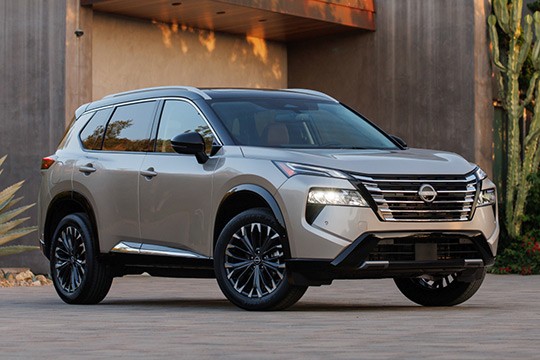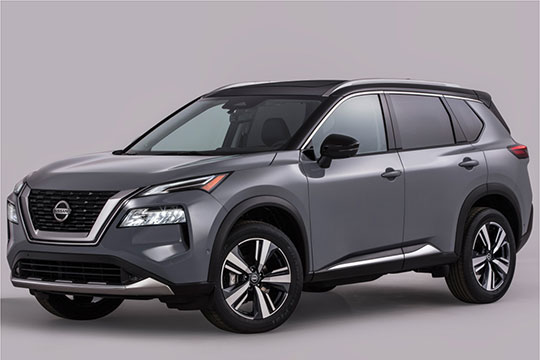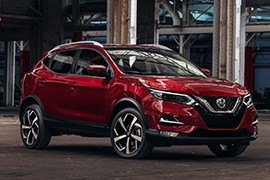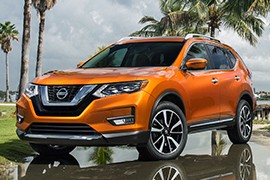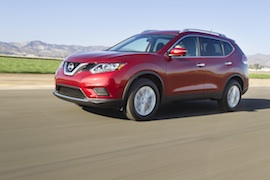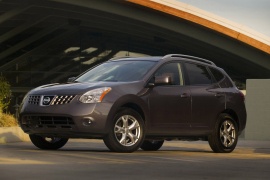NISSAN Rogue Models/Series Timeline, Specifications & Photos
First production year: 2007
Engines: Gasoline, Hybrid gasoline
Body style: SUV (Sports Utility Vehicle)
Nissan refreshed the Rogue lineup for the 2024 model year, and besides the fresh look of the exterior, it also greatly improved the interior and, especially, the infotainment system.
The Japanese automaker introduced the third generation of the Rogue in 2020, and that was not the right moment to launch a new vehicle due to the world pandemic situation. Still, Nissan didn’t want to let its customers wait and unveiled the vehicle anyway in the Summer of 2020. Then, the microchip crisis started and made things more complicated. But that didn’t defeat the carmaker either, and not only did it continue to sell the vehicle, but also its engineers continued working on the facelifted version of the Rogue. As a result, in the Fall of 2023, the third generation of this crossover was refreshed.
One of the basic rules for any successful facelift is to improve the vehicle’s front fascia, which Nissan did. The design team had a challenging job to upgrade something that already looked appealing. So, instead of the previously used grille with a 3D-mesh pattern, the 2024 model year Rogue came with an improved design that featured five horizontal chromed slats. The lower part of the bumper was also reshaped and featured a black underbody shield adorned by two satin-chromed trims instead of the formerly used aluminum-looking one. Nissan also added a set of 18” alloy wheels for the SV trim level, two-tone paint schemes, and new colors to the options list.
But the most significant improvement of the 2024 Rogue was on the interior, where the automaker upgraded the technology and connectivity package. It installed a 12.3” instrument cluster in front of the driver and a second 12.3” touchscreen atop the center stack for the Google-based infotainment system. These features were available for the SL and Platinum grades. In addition, the Apple CarPlay and Android Auto connectivity were kept in place, so users could use their smartphones to listen to their music, navigate, or stay in touch with their friends and family via phone conversations. These systems were wired for the S and SV grades, while the SL and Platinum ones were fitted with wireless connectivity systems. Passengers could sit comfortably either on the front bucket seats or on the rear split-folding (60/40) bench seat. Behind it, a 36.5 cu-ft. (1,033 liters) storage area could expand to up to 74.1 cu-ft. (2,098 liters) by completely folding down the rear seatback.
Under the hood, the 2024 Rogue was fitted with a 1.5-liter turbocharged gasoline unit paired with an improved version of the Xtronic CVT. Thanks to the improved start/stop system, the 201 hp (203 PS) engine was also very fuel efficient. The all-wheel-drive system was available as an option for all four grades: S, SV, SL, and Platinum, while the front-wheel-drive version was standard.
The Japanese car-maker Nissan unveiled the third generation of the Rogue in June 2020. It was based on the same platform as the European model X-Trail.
Nissan succeeded to become one of the best SUV car-makers in the world. Due to its substantial 4x4 experience combined with it's alliance partner Renault, the Japanese brand offered best-sellers around the world. The third generation of the Rogue was introduced to the North-American market to continue that successful story.
This time, the Nissan's designers took a bold approach when they drew the first lines on the car's front. With a set of lights on top of the front fenders and the main lights placed lower, it was different than the conventional system used before. A big black grille surrounded by a chromed rim enhanced the vehicle's look on the front fascia. The widened fenders and profiled doors gave an up-market look.
Inside, the Nissan's designers placed an in-dash infotainment unit, over the center stack, and it supported Apple CarPlay and Android Auto wireless connectivity. A large storage compartment filled the space between the front seats. The rear bench featured the "Zero Gravity" support and heated outboard seats as an option.
For the drivetrain, the Japanese engineers offered the Rogue with a 2.5-liter gasoline engine paired to a standard CVT. It sent the power in all corners via an intelligent all-wheel-drive system, that allowed a seamless torque-vectoring transfer.
Nissan has updated the infotainment system and now features standard Apple CarPlay and Android Auto. The facelifted version includes a new signature on its LED daytime running lights.
The front fascia has been redesigned and now it includes a V-shaped form borrowed from the Murano range. A new design was adopted also for the hood, and it involves a more aggressive and bolder look. Yet, it is not such a scary vehicle to see in the rear-view mirror. More like a fast SUV which will go, more often, bellow the speed limit on the freeway and on the HOV lane.
New design features mean new colors, including a beautiful Orange Metallic and a Lime Metallic, plus a new set of 19” wheels. Being designed as an all-rounder vehicle, compact-size SUV, the safety package was put on top of manufacturer's priority. Thus, it includes the advanced automatic braking system, pedestrian detection, lane departure warning, radar-based blind-spot monitor and high-beam assist.
The engine is the same 2.0-liter unit with four cylinders as before, which delivers 141 HP. The Nissan Rogue Sport is offered exclusively with an AWD system and a continuously variable transmission, called X-Tronic.. This ensures the best gear-ratio for each speed, leading to a very low fuel consumption, up to 32 MPG (7,3 l/100 km).
The 2016 Nissan Rogue was the facelifted version of the 2014 model, which was the same car as the one sold under the X-Trail nameplate in Europe.
The big competition in that segment forced the Japanese car-maker to refresh its model after just a couple of years after the introduction of the new generation. It added more safety options, such as pedestrian detection, Rear Cross-Traffic Alert, Lane Departure Warning, and Lane Departure Prevention. On top of that, a Forward Emergency Braking system was introduced to avoid rear-ending accidents.
The most striking exterior difference was at the front, where the grille featured two big chromed bars and a redesigned bumper. For the headlights, the 2016 model featured new Daytime Running Lights. A new pair of rectangular fog-lights was introduced in the fake air-intakes from the outer sides of the apron. The LED taillights were similar, but not the same.
The five-seat interior of the 2016 Rogue featured a driver-oriented dash and an SUV-driving position. Inside the instrument cluster, between the speedometer and tachometer, the 2016 model received a 5” color display for various functions of the car. The infotainment system was upgraded to a 7” touch-screen display. It was standard on the Sport SL trim level. The seven-seat interior was deleted from the options list. In the back, there was room for three on a split-folding bench.
The Rogue was available with a choice of front or all-wheel-drive system. It was powered by either a 2.5-liter unit or by a 2.0-liter hybrid system. Both versions were paired to an X-Tronic CVT transmission.
The 2014 Nissan Rogue was actually the same car as the one sold under the X-Trail nameplate in Europe.
It was Nissan's weapon on the SUV market, one of the biggest in the US. The new model was presented to the world with an optional 3rd row (7 seats), a new cargo system, and new on-board tech like the Around View Monitor that eased parking.
Another premiere for the Rogue in the US was the fact that it was the first car to use Renault-Nissan's Common Module Family platform that was accountable for a couple of the group's models.
As for under the hood tech, the new cars had an Xtronic CVT transmission that was even more efficient than the one on the previous generation. Since this car was meant for the US alone, it had only one engine available with 182 HP coming from a 2.5-liter engine that could be hooked up either to an all-wheel-drive system or a four-wheel-drive one.
The Rogue was available with two trim levels, S and SV. The S came with standard cruise control, air conditioning, 16-inch steel wheels, a trip computer and an AUX function. An optional package was available, adding 16-inch alloys, foglamps, a Bluetooth connection, steering wheel audio controls and a 4.3-inch audio screen.
The SV version included the above mentioned features and added 17-inch alloys, upgraded upholstery and keyless ignition.
In 2007, Honda CR-V already had 10 years on the market and the Toyota Rav 4 was a serious competitor. In late 2007, Nissan launched its competitor in the segment, the Rogue.
The Rogue was based on the successful Sentra sedan model, a vehicle that proved its worthiness on the market. But while the Sentra didn't need a V6 engine, in the SUV market that option was often checked by customers.
From the outside, the designers of the Rogue took some clues from its bigger brother, the Murano. Unlike most of the car market, the grille was painted in the bodywork color. Its tall headlights were uncommon for the design trends, but that was one of the vehicle's idea: to look familiar but somehow different than the other cars on the market.
Inside, the Rogue was well equipped even in the base trim level. It features numerous storage compartments, including one under the trunk's floor. The audio system was provided by Bose and featured a CD-player and a 3.5mm jack AUX-in. Thanks to the Sentra's platform and the high greenhouse, the Rogue offered plenty of room for the rear passengers, where ISOFIX child-seats could have been installed.
Under the hood there was only one engine option, a 2.5-liter four-pot unit. It was mated to a standard CVT (continuously variable transmission). The Rogue was offered with front or all-wheel-drive.
